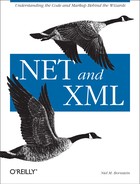Building a SQL Command
In the examples so far, I’ve built the SQL commands as simple text. There is another way that’s more flexible. Of course, more flexibility usually involves more code.
The basic concept is that an
IDbCommand.Parameters property returns an
IDataParameterCollection, which is a collection of
IDataParameter instances. The
IDataParameter interface’s
properties include the name of a parameter coded into the
IDbCommand, and the value you wish to bind to that
name. Look at the following code snippet for an example:
SqlCommand command = new SqlCommand(
"insert into coupons ( coupon_code, discount_amount, " +
"discount_type, expiration_date ) " +
"values ( @coupon_code, @discount_amount, @discount_type, " +
"@expiration_date )", connection);
command.Parameters.Add(new SqlParameter("@coupon_code", "665RQ"));
command.Parameters.Add(new SqlParameter("@discount_amount", 15));
command.Parameters.Add(new SqlParameter("@discount_type",
DiscountType.Percentage));
command.Parameters.Add(new SqlParameter("@expiration_date ",
new DateTime(2002,11,30)));
As
you can see, the names of the parameters are embedded into the SQL
command itself. Each parameter is then added to the
IDataParameterCollection as a
SqlParameter, with its name and value. The names
I’ve used in this snippet match the names of the
respective columns, with an @ prefixed; while the
naming of the parameters is entirely up to you, the
@ prefix is required.
You
can use the Parameters property on any
IDbCommand, for any select,
insert, update, or
delete statement. There are other properties to
the IDbParameter subclasses that pertain to the
specific types of databases they know about.
The major
benefit of building an IDbCommand this way is that
every parameter can be assigned dynamically, instead of having to
hard-code the command by repeatedly appending strings. Another
benefit is that type conversion is automatic, so you
don’t have to use the ToString( )
method or any sort of string formatting to get a value that the
database will accept. Finally, most database servers actually run
more efficiently when a query is built this way; the query does not
need to be parsed again every time it is run again with different
data values.
Example 11-3 shows how both these benefits can be
exploited in a rewritten version of the AddCoupon
program from Example 11-2.
using System;
using System.Data;
using System.Data.SqlClient;
public class AddCoupon {
public static void Main(string [ ] args) {
SqlConnection connection = new SqlConnection(
"Initial Catalog=AngusHardware; User ID=sa");
SqlCommand command = new SqlCommand(
"insert into coupons ( coupon_code, discount_amount, " +
"discount_type, expiration_date ) " +
"values ( @coupon_code, @discount_amount, " +
"@discount_type, @expiration_date )", connection);
SqlParameter couponCode = command.Parameters.Add(
new SqlParameter("@coupon_code", SqlDbType.Char));
SqlParameter discountAmount = command.Parameters.Add(
new SqlParameter("@discount_amount", SqlDbType.Decimal));
SqlParameter discountType = command.Parameters.Add(
new SqlParameter("@discount_type", SqlDbType.TinyInt));
SqlParameter expirationDate = command.Parameters.Add(
new SqlParameter("@expiration_date", SqlDbType.DateTime));
connection.Open( );
couponCode.Value = "99GGY";
discountAmount.Value = 5d;
discountType.Value = DiscountType.Percentage;
expirationDate.Value = new DateTime(2002,12,31);
command.ExecuteNonQuery( );
command.Parameters["@coupon_code"].Value = "81BIN";
command.Parameters["@discount_amount"].Value = 10d;
command.Parameters["@discount_type"].Value = DiscountType.Fixed;
command.Parameters["@expiration_date"].Value =
new DateTime(2003,1,31);
command.ExecuteNonQuery( );
connection.Close( );
}
}
This example shows two ways to deal
with the SqlParameter objects. Each of the
SqlParameter objects is created and added to the
SqlCommand’s
Parameters property, which is a
SqlParameterCollection. The Add(
) method returns the newly created
SqlParameter, which is then assigned to a local
variable.
For the first execution of the
SqlCommand, the SqlParameter
instances are accessed by the local variables, and their values are
assigned using the Value parameter. The
SqlCommand.ExecuteNonQuery( ) method causes the
SQL statement to be executed with those values.
In the second SqlCommand execution, the
SqlParameter instances are accessed by name using
the SqlParameterCollection’s
indexer (the other indexer accesses a SqlParameter
by its integer index). Then, like before, its
Value is set and the SqlCommand
is executed with those values.
